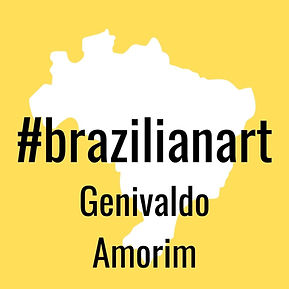DAL DISEGNO ALLA CONDIVISIONE – INTERVISTA A GENIVALDO AMORIM
Genivaldo Amorim è il secondo artista che abbiamo deciso di intervistare per #brazilianart, ed è stata una scelta non a caso, perché lui rappresenta l’arte opposta, per alcuni versi, rispetto a quella di Sergio Adriano H.
Nato nello Stato del Paranà nel Sud del Brasile, si trasferisce molto giovane nello stato confinante, Mato Grosso do Sul, dove cresce. All’età di 18 anni, insieme ai genitori, arriva a Valinhos nello stato di San Paolo, dove vive e lavora tutt’ora.
L’arte entra nella sua vita quando lui è ancora giovane, grazie ad un suo professore, che lo stimola ad iniziare a disegnare – “ io che non ero mai entrato in un museo, non avevo mai visto una mostra…” – decide quindi di fare un corso per posta di disegno; ma solo quando arriva a Valinhos e visita la sua prima mostra scopre per la prima volta cosa sia veramente l’arte.
L’inizio della sua produzione è fatta di disegni e ritratti, per poi passare all’astratto, e approdare, infine, all’installazione.
Le opere di Genivaldo sono in costante evoluzione, raramente i suoi progetti hanno un’inizio e una fine, se non è soddisfatto di un’opera la cambia anche se quell’opera è già stata esposta al pubblico. Molte di esse sono create apposta per uno spazio (il site specific) e vengono pensate dopo la scelta di quest’ultimo. Come il progetto “Organicidade” che nasce in un modo, appeso su fili di nylon in centro alla stanza, per poi venire in una secondo momento raggruppato e appeso al muro per questioni di spazio, creando così qualcos’altro che ha un senso ancora più profondo, importante e….piace!
Una delle tematiche centrali del suo lavoro è il corpo, tema che ha affrontato per prima nella sua produzione, con la serie “carne viva”, e poi con “Espinhaço”, parola utilizzata per indicare la colonna vertebrale, l’opera è composta da materassi dipinti, a simboleggiare il posto dove appoggiamo la nostra colonna vertebrale e che molte persone nel mondo non hanno accesso, questi materassi alla fine dell’esposizione “Do outro lado do vidro velho paisagens alheias” che si è tenuta a Maputo in Mozambico, sono stati donati alla popolazione.
Le installazioni di Genivaldo sono molto diverse tra di loro, e con tematiche che spaziano dal popolare al religioso, come “bacia das almas”: installazione fatta con delle bacinelle appese in diverse altezze sul soffitto da un filo di nylon, come sospese nell’aria nel gesto di ascensione verso l’alto, e coperte da asciugamani rossi fatti all’uncinetto.
L’opera è la materializzazione di un modo di dire brasiliano “bacia das almas”, usato per riferirsi a qualche impresa che è stata raggiunta utilizzando le ultime risorse disponibili. Ma ha origine nella chiesa cattolica francese, “Bassin des âmes du purgatoire”, che erano persone che svolgevano il compito di raccogliere soldi per finanziare le messe a favore delle anime del purgatorio, affinché potessero calmarsi pagando il proprio debito e così accedere in paradiso.
Ma il lavoro di Genivaldo non si limita soltanto allo spazio chiuso e alle installazioni. Uno dei focus più importanti della sua produzione è quella di passare un messaggio importante alle persone, e sono, appunto, queste ultime, i “co-autori” dei suoi lavori. Come una vera e propria arte relazionale, Genivaldo crea per poi far dilagare la sua arte nel mondo .
Esempio lampante è l’opera “word body project”, dove Genivaldo ha creato delle magliette di colore rosso con scritto il peso del suo corpo nel momento in cui vengono prodotte queste magliette, e il pubblico si fa fotografare in giro per il mondo con quella maglietta. (Nella terra ferma, ma anche sott’acqua!!!!)
L’arte che gira il mondo senza fare un passo….l’arte che dilaga senza dover chiedere di essere portata in giro… quanto è bella questa cosa?
Quando ho chiacchierato con Genivaldo, gli ho detto che mi ricordava tantissimo uno degli artisti che più amo in assoluto, Felix Gonzalez-Torres, per condivisione e relazione con il pubblico, e per me è così importante questa similitudine, perché vuol dire che molte volte l’arte è unica e che funziona quando è davvero condivisa con tutti e si trasforma; questa trasformazione e netta nelle opere di Genivaldo, cioè da arte si trasforma in mero oggetto del quotidiano, a seconda di chi lo utilizza, come “Feira” una grande installazione di 58 buste utilizzate per fare la spesa, dove in ognuna c’è il nome di una galleria d’arte di San Paolo che ha partecipato alla SP-arte (principale fiera d’arte brasiliana) , quest’opera è stata esposta a Mozambico, in un area dove le persone sono molto povere e non hanno accesso sicuramente all’arte. Quelle buste dopo la mostra sono state donate alla popolazione per poter andare a fare la spesa e comprarsi da mangiare. L’arte, quindi, si trasforma in qualcosa di veramente utile…e chissà quanta gente è in giro adesso a fare la spesa con un’opera di Genvaldo in mano???
Se vuoi conoscere un pochino di più su questo meraviglioso artista visita il suo sito
Come sempre ringrazio Tomas Cajueiro per il supporto in questo bellissimo progetto.
A giovedì 24 febbraio con un nuovo #brazilianart

.jpg)























